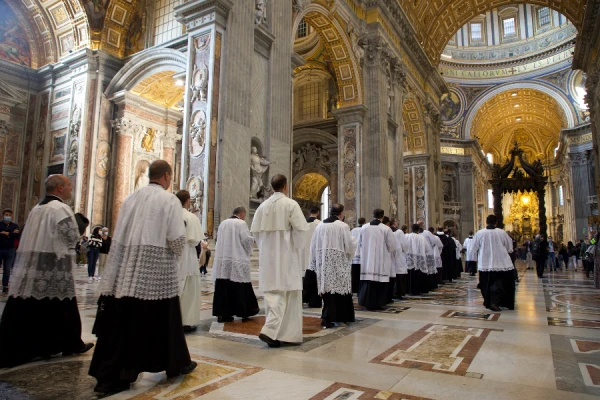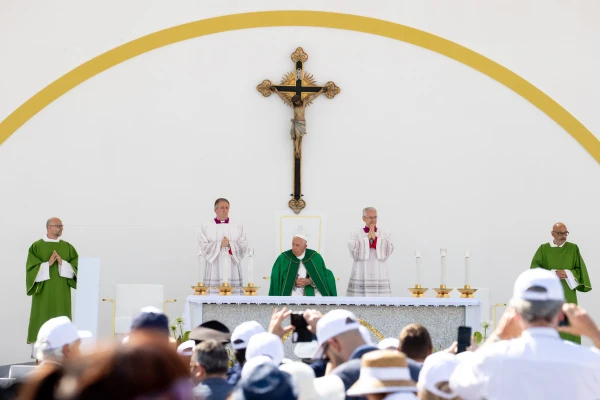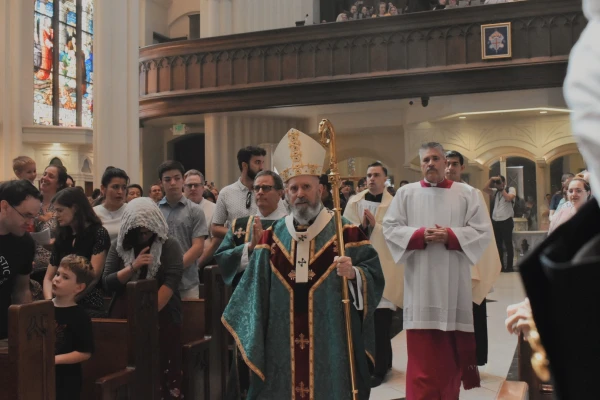CNA Staff, Jul 30, 2024 / 11:00 am
Catholics and even non-Catholics around the world have recently been imploring Pope Francis to refrain from implementing a rumored ban on the Tridentine Mass, also known as the Traditional Latin Mass (TLM).
The Vatican has imposed restrictions on the TLM in recent years, with the Holy Father arguing that the centuries-old Latin Mass was being used in “an ideological way” by Catholics.
Rumors have circulated recently that the Vatican is preparing to impose an even stricter ban on the liturgy. A broad coalition of Catholics and non-Catholic advocates, both from the Americas and from Europe, have implored Francis to allow the TLM to continue.
A Mexican archbishop emeritus, meanwhile, earlier this month urged Pope Francis not to ban the ancient form, begging him: “Do not allow this to happen.”
What changed between liturgies?
The Tridentine Mass has long held a prominent place not just in Church history but in wider culture; many non-Catholics are familiar with its ornate liturgical processes, its high solemnity, and its use of ancient music, bells, and incense.

The official form of the Mass was codified following the Council of Trent in the 16th century. It remained the dominant form of Catholic liturgical worship until the promulgation of the Mass of Paul VI — also known as the “novus ordo” or the “ordinary form” — in 1969. (The TLM is also referred to as the “extraordinary form.”)
Among the most notable changes to the Mass was the allowance of “the vernacular” in the liturgy. Whereas the TLM is celebrated in the ancient Latin language, the novus ordo allows for the use of modern, local languages in the Mass.
Father John Baldovin, SJ, a professor of historical and liturgical theology at Boston College, told CNA that the linguistic revisions of the Mass stemmed from “a pastoral liturgical movement which sought to increase the people’s active participation in the liturgy.”
This “led to a desire for a liturgy in the language of the people,” he said.
The Second Vatican Council’s Constitution on the Sacred Liturgy notes that “in Masses which are celebrated with the people, a suitable place may be allotted to their mother tongue.”
The document does stipulate that “steps should be taken so that the faithful may also be able to say or to sing together in Latin those parts of the ordinary of the Mass which pertain to them.”
Advocates have claimed that permitting liturgies in vernacular languages allows for the faithful to become “actively engaged in the rite and enriched by its effects,” as the Second Vatican Council put it.
Others have argued that the Latin language allows for a more constant and enriching liturgy. Nigerian Cardinal Francis Arinze has written that the ancient and unchanging language “fits a Church which is universal, a Church in which all peoples, languages, and cultures should feel at home and no one is regarded as a stranger.”
Another major change was the allowance for priests to celebrate the Mass facing the congregation.
(Story continues below)
The Tridentine rite dictated that the priest face “ad orientem,” or “to the east”; the current General Instruction on the Roman Missal, however, directs that it is “desirable whenever possible” that the celebrant faces the people.

In 2000, Cardinal Jorge Medina Estevez, then-prefect of the then-Congregation for Divine Worship and the Discipline of the Sacraments, clarified that “the position toward the assembly seems more convenient inasmuch as it makes communication easier,” but that the present missal does not exclude facing “ad orientem.”
The priest’s facing toward the people remains the dominant celebration of the Mass today. Estevez noted that the “spiritual orientation” of the act of worship should be distinguished from the priest’s physical direction.
“If the priest celebrates ‘versus populum,’ which is legitimate and often advisable, his spiritual attitude ought always to be ‘versus Deum per Jesus Christum’ [toward God through Jesus Christ], as representative of the entire Church,” he wrote.

Jimmy Akin, a senior apologist at Catholic Answers, told CNA that another major change was “the expansion of the liturgical readings from a single-year cycle to a three-year cycle for Sundays and holy days and a two-year cycle for other days.”
“The new cycles also include a reading from the Old Testament, which was mostly absent from pre-Vatican II readings,” he said.
These cycles “do not cover every passage in the Bible,” he noted, but “the change was made to give the faithful a broader exposure to the contents of Scripture.”
Akin noted that the Church has periodically issued changes to the liturgy over the centuries.
“There have always been minor revisions to the rites of Mass, such as the Leonine Prayers or ‘Prayers After Mass’ that were added to the celebration of low Masses by Leo XIII in 1884,” he said.
Other changes in the novus ordo arose from less direct yet still consequential revisions.
The ornate vestments and solemn processions of the Tridentine Mass, for instance, have faded in favor of much more simplified liturgical trappings.
The Constitution on the Sacred Liturgy directed that “the rites are to be simplified” and that “elements which, with the passage of time, came to be duplicated, or were added with but little advantage, are now to be discarded.”

Though many ancient elements of the liturgy were discarded in the revised missal, several other notable practices were restored, including the “prayers of the faithful” and the penitential act.
Those elements of the liturgy had “suffered injury through accidents of history,” the council noted, and were “now to be restored to the vigor which they had in the days of the holy Fathers.”






